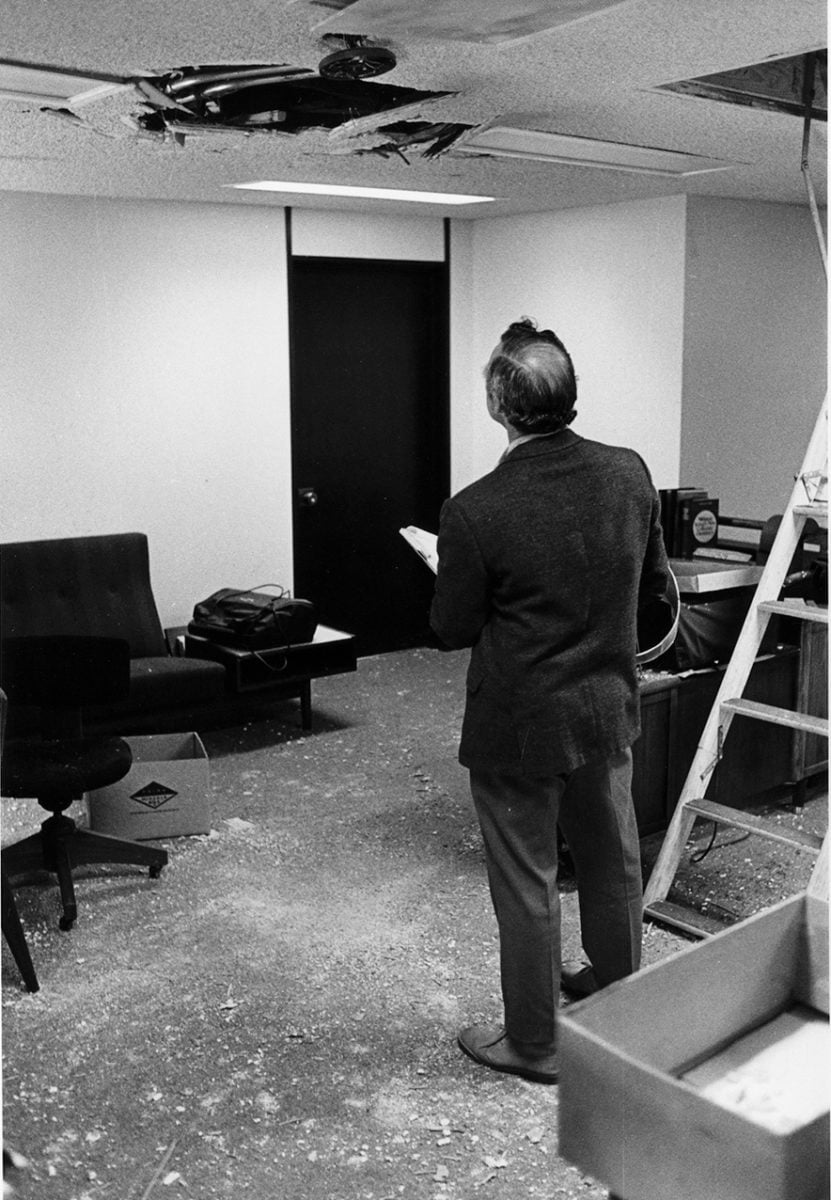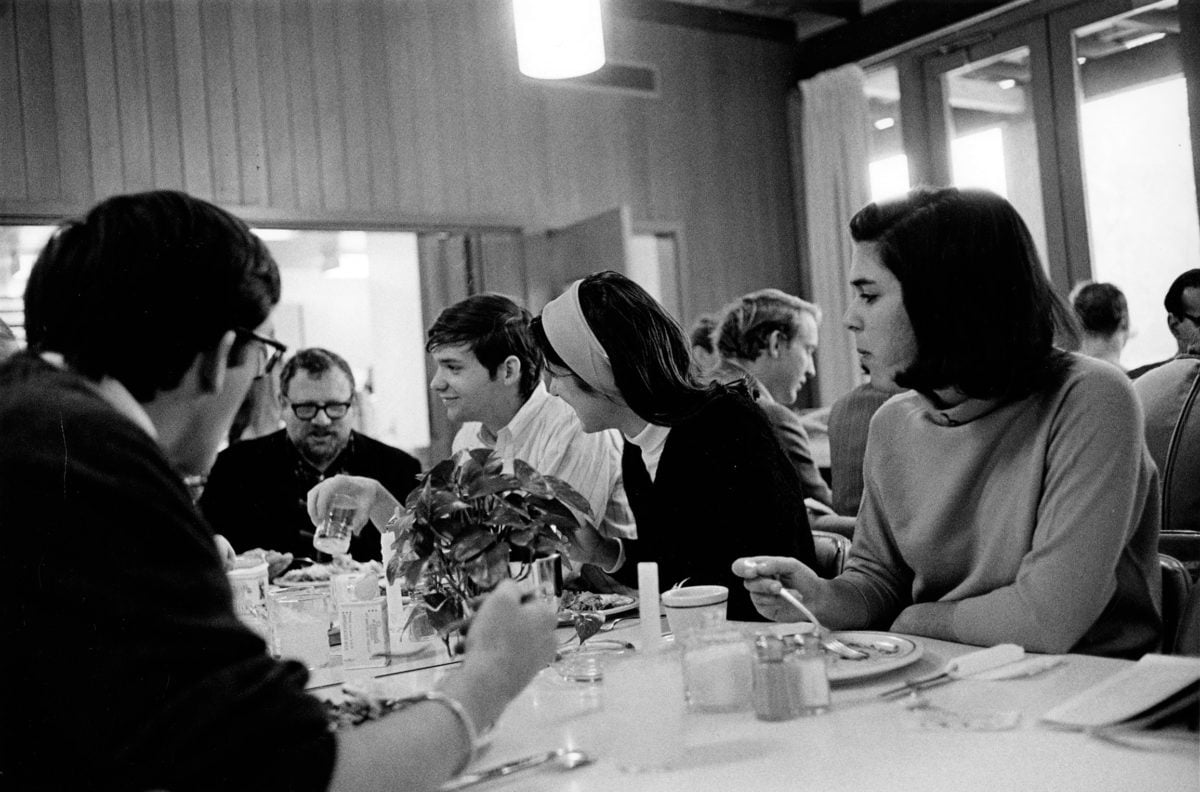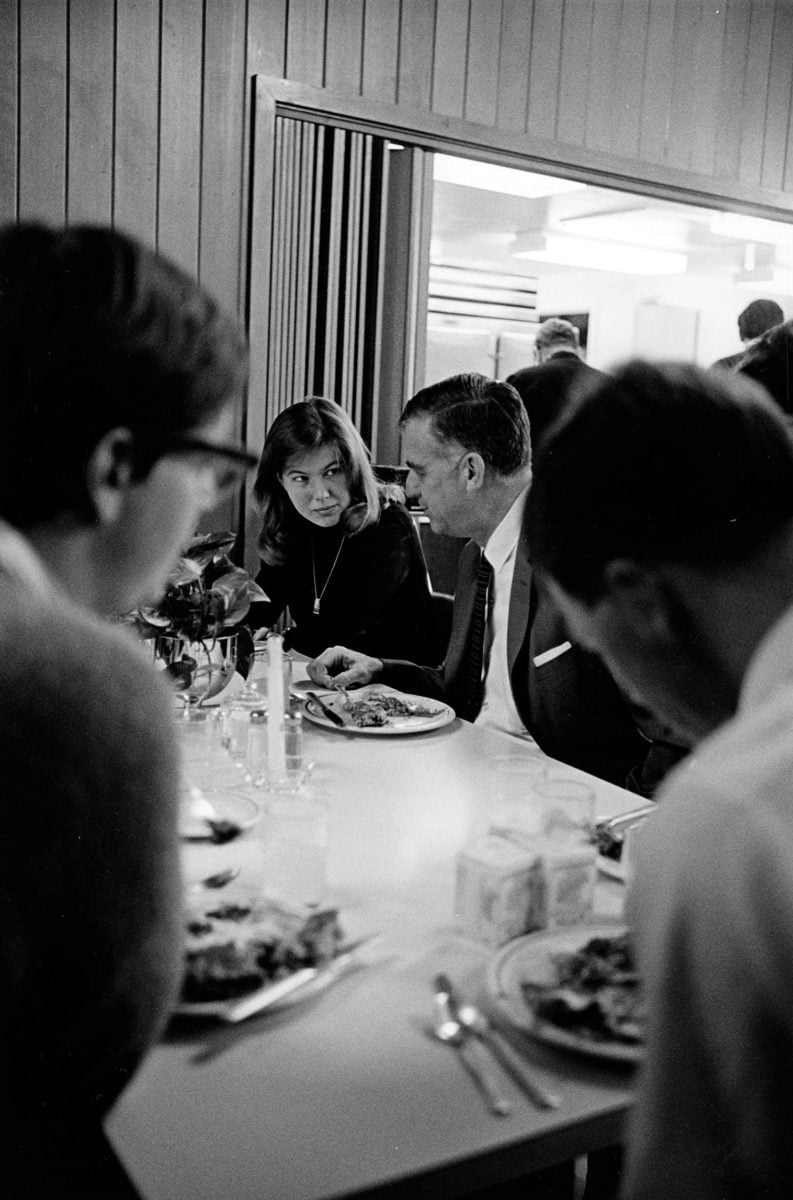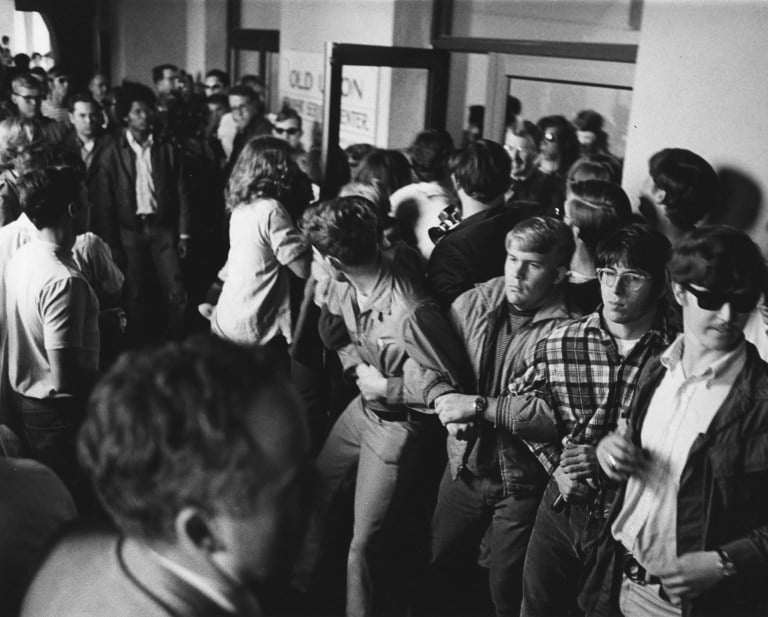Koinozetetics.
Definition: a program in controlled speculation.
Confused? You should be. It’s not a term you’ll find in any dictionary. Conceived by former Stanford history professor Mark Mancall in 1971, “koinozetetics” is a combination of two words from the Greek language: “koinos” for “common, in common, mutual” and “zététique” for “to seek, to enquire.”
Mancall created the word when, despite speaking 15 languages, he could not find the words to capture the moment he found himself in. Students across the country were protesting the Vietnam War, and Stanford was no exception. From sit-ins at Old Union to bombings at the University president’s office, students made their outrage about the war — and the University’s involvement in the conflict — known.

At the same time, the University was doing something that other schools in the country weren’t: experimenting with co-ed residences. Amid the madness, Mancall witnessed a need for an alternative form of education that went beyond the University’s general education requirements.
The solution? Koinozetetics: a program in controlled speculation.
While the term was short-lived, the vision for the program was not. Mancall, who passed away a year ago, went on to originate the University’s Structured Liberal Education (SLE) program in 1973 — a “residence-based academic program that encourages students to live a life of ideas in an atmosphere that emphasizes critical thinking and interpretation,” according to SLE’s website.
Years later, SLE remains Stanford’s longest-running program for freshmen.
Every year, no more than 99 students opt-in to be part of this one-year residential community where they study how the words of ancient Greek philosophers influenced the painters and poets in the Renaissance, or how ideas from Daoism speak to enlightenment thinkers. In other words, SLE is a small, tight-knit, liberal arts program nested within a sprawling research university.
The study of the humanities at a school like Stanford — a university surrounded by Silicon Valley where 20% of all undergraduates major in computer science — is often overshadowed. According to the Stanford Tech History Project, the rise of the tech industry in Silicon Valley corresponded to a decrease in students studying the humanities — a problem that the University flagged as early as 2011.
But to some, Stanford’s prevalent STEM culture and symbiotic relationship with Silicon Valley is a problem that goes beyond enrollment in humanities courses.
Jeremy Sabol, associate director of the SLE program, finds the culture of Silicon Valley “corrosive.”
“Silicon Valley is teaching you and your parents and Stanford donors that what college is really about is vocational — it’s about elite training to get really great jobs at Google and Facebook,” Sabol said. “And that’s the worst form of education. It repeats social classes. It keeps everyone in line and keeps the rich, rich and the poor, poor.”
Providing the undergraduate population with an educational experience that is committed to the advancement of knowledge — and not just the advancement of one’s job prospects — is something that the University continues to grapple with. From “Western Civ” to “Western Cultures” to “Cultures, Ideas and Values” to “Introduction to the Humanities (IHUM)” to “Thinking Matters” and now “Civil, Liberal, and Global Education (COLLEGE),” the University’s general education requirements have gone through six different makeovers since SLE’s founding.
So why can’t Stanford seem to get it right? It’s complicated, but the answer can be summed up with two underlying issues: a structural problem in the University’s approach to education and a cultural attitude toward non-STEM classes from the student body.
“I think that it helps to have a historical perspective on the University,” said Dan Edelstein, a French professor and the faculty director of Stanford Introductory Studies. “The University is not a single entity; in the words of Clarke Kerr” — the former chancellor of UC Berkeley — “we’re a multiversity.”
The first modern research university can be traced back to Berlin in 1810, according to Edelstein. Founded by Wilhelm von Humboldt, the first departments in research universities were more concerned with graduate studies — a trend that can still be found within most departments.
“If you look at most majors, they are still kind of designed to prepare graduate students in that field,” Edelstein said. Similarly, when departments at Stanford hire professors, they are not necessarily “trained to think about the overall undergraduate experience,” according to Edelstein.
“A research university is very much about the departments,” SLE lecturer Greg Watkins ’85 Ph.D. ’03 noted. As a result, Watkins’s “biggest criticism of the rest of the university is that its educational system is piecemeal.”
In other words, Watkins remains frustrated by the University’s lack of a robust, introductory undergraduate education. Although he recognizes that the office of the Vice Provost for Undergraduate Education (VPUE) is trying to solve those problems, he feels that VPUE and the other academic departments are “not always in sync.”
Professor of Communications Fred Turner also noted that students’ perceptions toward the humanities contribute to a culture where non-STEM disciplines are not taken seriously. Turner pointed to the Stanford-specific terms “techies” and “fuzzies” as one example, where the term “techies” refers to students in STEM and the term “fuzzies” refers to students in non-STEM fields.
“I think that’s just ridiculous,” Turner said. “The culture of Stanford needs to celebrate humanists in a way that it celebrates the STEM fields. The question becomes, ‘How we teach them?’ — and that’s what is very much on my mind.”
Despite the University’s consistent problem with teaching the humanities, Stanford’s SLE program continues to flourish and has hardly changed since its inception. Every year, SLE is able to fill close to program capacity, and a quick course-evaluation search reveals a myriad of positive reviews.
But at a school as tech-oriented as Stanford, what makes this humanities-intensive program so successful? And how can the University extend that deeply holistic arts and humanities education to its entire undergraduate population?
From late night toga parties to late night Socratic debates
The story of SLE begins with a not-so-intellectual, Greek-themed gathering: a toga party at the Phi Delta Theta (Phi Delt) fraternity house in 1966. The Phi Delts invited women from Mills College to their party and expected a night full of fun — so much, in fact, that they ended up on the front page of the San Francisco Chronicle the next day.
“They had turned the TV room into a dressing room for the girls, but rowdy, drunken boys barged in,” according to SLE co-founder Jon Reider ’67 Ph.D. ’83.
The University suspended Phi Delt after the incident and turned the fraternity house into the Grove Project — the University’s first attempt at co-ed housing, led by none other than Mancall.
“The idea behind it was to create a different kind of residence at Stanford, not only because it was co-ed — that in some ways was the least of it, as revolutionary as that was — but also because it was a departure from the conventional residence, because it had an academic program,” said Phil Taubman ’70, who participated in Grove Project the year it was launched. Taubman is a former editor-in-chief of The Stanford Daily and remains an involved alumnus.
The residence quickly grew a reputation as Stanford’s center of intellectual life. Faculty and students flocked from all over campus to participate in the Grove community. Sometimes, that participation looked like taking a student-led Grove Project seminar on topics ranging from “Jewish Gypsy Mysticism” to “Madness and History.” But one event at Grove was particularly important: dinner time.

Taubman compared the setting at the dinner tables to the high tables at Oxford — an intellectual tradition where students and faculty gather for what he describes as a “real conversation.”
“Mark had this idea … if he could create a kind of intellectual atmosphere at the dinner table, it would allow an opportunity for students and faculty and graduate students and visitors to spend the early part of the evening talking about whatever was going on in the world,” Taubman said.
At Grove, Mancall decorated the dining room with white tablecloths and candles. Students lined up all along the dorm’s hallway as a chef prepared their food. People would stay for hours talking about everything from the ongoing Vietnam War to their own academic niches.
Although the Grove Project experiment ended in 1973, the University recognized the program’s success. Co-ed living quickly spread to other dorms. But to Mancall, that was a small fraction of Grove Project’s success. He witnessed the strength of Grove’s academic, residential structure and wanted to create a program that went beyond what he called the University’s “cafeteria style of general education.”

The following academic year, Mancall hosted his first SLE seminar with 20 students in Wilbur Hall. He wanted the students to walk away from the experience “slightly dissatisfied and uncomfortable,” according to an old Daily article.
Forty-nine years later, the tradition continues.
While some aspects of the SLE program have changed since its founding, much of it remains the same. Students are still reading works by Plato, Dante and Karl Marx as part of their curriculum. Furthermore, SLE’s structure remains identical. Students pile into their dorm lounge on Tuesday afternoons and evenings to hear lectures from faculty. On Wednesdays and Thursday afternoons, students discuss the lectures and texts for the week in small sections. And in the spirit of the Grove Project, students typically continue their discussions of Plato or Marx over dinner in the dining halls.
But SLE has not gone the last 49 years unscrutinized — far from it. A common criticism of SLE, and one that I frequently heard when I was part of the program in 2019, is that its curriculum is “too Western” and does not include enough voices from historically underrepresented communities.
When I was in SLE, I was one of those frosh who walked away from the program “slightly dissatisfied and uncomfortable” — and one of my instructors for SLE said that I should walk away from the program with mixed feelings. I benefitted first-hand from the residential community and listened to lectures from professors I probably wouldn’t have met otherwise.
Yet the curriculum’s content never fully sat right with me. I understood that I signed up for a program focused on Western thought, but I also wondered, “What are we talking about when we say Western thought? When we read people like John Locke and Thomas Jefferson, why can’t we also read Frederick Douglass and Ida B. Wells?“
This criticism is all too familiar to SLE lecturers. Since SLE heavily relies on guest lecturers, SLE faculty are hesitant to include a text if they can’t find an outside faculty member to come in and lecture on it.
At the same time, SLE was designed to meet the political unrest of the Vietnam War by showing the flow of Western ideas from the past up to the present moment. “Those of us who teach in SLE are teaching in a program that was designed to do what it’s doing,” Watkins said.
Now, the curriculum is again trying to meet the moment. With the rise of cultural movements at Stanford like “Who’s Teaching Us?,” SLE faculty are also including authors like W.E.B. DuBois and Toni Morrison in their curriculum.
So what does it mean then for SLE to stay authentic? Does it look like reading most of the original texts that demonstrate the flow of Western ideas? Or does it look like a call and response to the immediate anxieties and concerns of students today?
SLE and the University
On a campus as spread out as Stanford, creating a cohesive, central community for students to call home can be difficult. SLE solves this problem with a residential-based learning model.
For Noah Sveiven ’24, the built-in community was the highlight of the program.
“It’s how we learned that stays with me,” Sveiven said. “You eat together. You go sit and listen to these lectures together. You talk about the lectures afterward. You go and sit and talk about books together.”
Watkins, who also participated in SLE when he was a freshman, feels similarly about the residential-based program. The program was so impactful for him that he and a group of students even tried to start a second-year SLE program (although it did not last).
“I believe in SLE immensely and have committed my career to it because I believe in the year-long intensive structure and nature of it,” Watkins said.
Not every student at Stanford will get the small, residential experience that SLE brings. But Watkins and Sabol both believe that every student at Stanford can, and should, receive a strong liberal arts education. Neither Sabol nor Watkins has a clear solution to the problem, but they would both like to see the University better communicate the importance of the humanities to the student body.
According to Sabol, the tools to solve some of the world’s most pressing issues lie within humanities courses, but students don’t always realize that.
He is not alone in this view. Computer science professor Mehran Sahami Ph.D. ’99 has publicly advocated for more STEM students to take humanities courses. Sahami believes that more interdisciplinary approaches to education are key to addressing the ethical issues in the tech industry.
As part of his effort to close the gap between the humanities and STEM, Sahami co-teaches CS 182: Ethics, Public Policy, and Technological Change. The course aims to look at technology through the lens of philosophy and public policy, pushing students to think about the ethical implications and societal impact of the technology they build.
Turner is also part of that effort to bridge the gap between the humanities and STEM at Stanford. As a former director of the Science, Technology and Society major, he helped build a department “in which students had to do essentially two-thirds of a major in a STEM field and two-thirds of a major in a humanistic or social science field.” As a result, students graduate fluent in both STEM and non-STEM disciplines.
From a non-departmental perspective, Sabol believes that the University’s most recent general education requirement, COLLEGE, is a step in the right direction.
From courses like “Citizenship in the 21st Century” to “Why College? Your Education and the Good Life,” the new general education requirement aims to push students to reflect on their education as more than a means to a high-earning job.
Turner feels similarly about the new COLLEGE program. As an instructor, it is important to Turner that students not only explore “new ideas and worlds,” but also reflect on their education in ways that encourage them to see it “not simply as a pre-professional training space, but as a unique, four-year chance to think about what it means to be human.”
“And that’s what COLLEGE will do,” Turner said.
The faculty are all eager to bring the humanities back into the first-year experience, and to breathe a love for learning and intellectual curiosity back into the general education requirements.
“I think that for a long time, we misunderstood our students — we thought that our students didn’t care anymore about the humanities or about even the social sciences,” Edelstein said. “What we learned … was that our students are just really frightened. They’re really anxious. It’s a scary world. I think that if we address those anxieties and talk about them with our students, then that’s a great place to start.”
